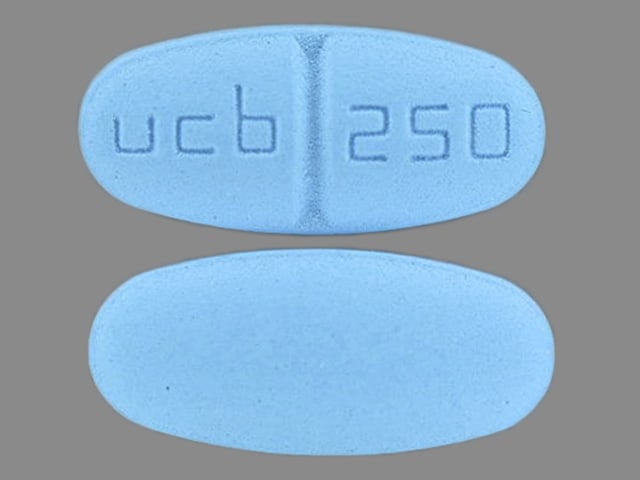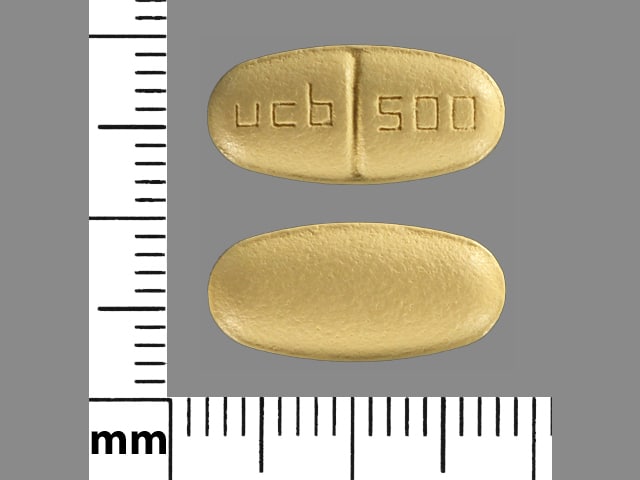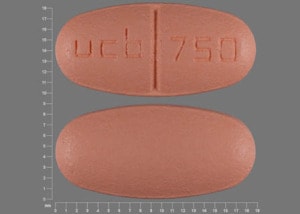Keppra
Generic name: levetiracetam (oral/injection)
Brand names: Keppra, Keppra XR
Drug class: Pyrrolidine anticonvulsants
Medically reviewed by A Ras MD.
What is Keppra?
Keppra is a prescription medicine taken by mouth that is used to treat partial-onset seizures in people 1 month of age and older.
Keppra is a prescription medicine taken by mouth that is used with other medicines to treat myoclonic seizures in people 12 years of age and older with juvenile myoclonic epilepsy, primary generalized tonic-clonic seizures in people 6 years of age and older with certain types of generalized epilepsy.
It is not known if Keppra is safe or effective in children under 1 month of age to treat partial-onset seizures, 12 years of age to treat myoclonic seizures, 6 years of age to treat primary generalized tonic-clonic seizures
Before taking your medicine, make sure you have received the correct medicine. Compare the name above with the name on your bottle and the appearance of your medicine with the description of Keppra provided below. Tell your pharmacist immediately if you think you have been given the wrong medicine.
Description
KEPPRA injection is an antiepileptic drug available as a clear, colorless, sterile solution (100 mg/mL) for intravenous administration.
The chemical name of levetiracetam, a single enantiomer, is (-)-(S)-α-ethyl-2-oxo-1-pyrrolidine acetamide, its molecular formula is C8H14N2O2 and its molecular weight is 170.21. Levetiracetam is chemically unrelated to existing antiepileptic drugs (AEDs). It has the following structural formula:

Levetiracetam is a white to off-white crystalline powder with a faint odor and a bitter taste. It is very soluble in water (104.0 g/100 mL). It is freely soluble in chloroform (65.3 g/100 mL) and in methanol (53.6 g/100 mL), soluble in ethanol (16.5 g/100 mL), sparingly soluble in acetonitrile (5.7 g/100 mL) and practically insoluble in n-hexane. (Solubility limits are expressed as g/100 mL solvent.)
KEPPRA injection contains 100 mg of levetiracetam per mL. It is supplied in single-use 5 mL vials containing 500 mg levetiracetam, water for injection, 45 mg sodium chloride, and buffered at approximately pH 5.5 with glacial acetic acid and 8.2 mg sodium acetate trihydrate. KEPPRA injection must be diluted prior to intravenous infusion
Mechanism of Action
The precise mechanism(s) by which levetiracetam exerts its antiepileptic effect is unknown.
A saturable and stereoselective neuronal binding site in rat brain tissue has been described for levetiracetam. Experimental data indicate that this binding site is the synaptic vesicle protein SV2A, thought to be involved in the regulation of vesicle exocytosis. Although the molecular significance of levetiracetam binding to synaptic vesicle protein SV2A is not understood, levetiracetam and related analogs showed a rank order of affinity for SV2A which correlated with the potency of their antiseizure activity in audiogenic seizure-prone mice. These findings suggest that the interaction of levetiracetam with the SV2A protein may contribute to the antiepileptic mechanism of action of the drug.
What is the most important information I should know about Keppra?
Like other antiepileptic drugs, Keppra may cause suicidal thoughts or actions in a very small number of people, about 1 in 500 people taking it.
Call a healthcare provider right away if you have any of these symptoms, especially if they are new, worse, or worry you:
- thoughts about suicide or dying
- attempts to commit suicide
- new or worse depression
- new or worse anxiety
- feeling agitated or restless
- panic attacks
- trouble sleeping (insomnia)
- new or worse irritability
- acting aggressive, being angry, or violent
- acting on dangerous impulses
- an extreme increase in activity and talking (mania)
- other unusual changes in behavior or mood
Do not stop Keppra without first talking to a healthcare provider.
- Stopping Keppra suddenly can cause serious problems. Stopping a seizure medicine suddenly can cause seizures that will not stop (status epilepticus).
- Suicidal thoughts or actions can be caused by things other than medicines. If you have suicidal thoughts or actions, your healthcare provider may check for other causes.
How can I watch for early symptoms of suicidal thoughts and actions?
- Pay attention to any changes, especially sudden changes, in mood, behaviors, thoughts, or feelings.
- Keep all follow-up visits with your healthcare provider as scheduled.
Call your healthcare provider between visits as needed, especially if you are worried about symptoms.
Who should not take Keppra?
Do not take Keppra if you are allergic to levetiracetam.
What should I tell my healthcare provider before taking Keppra?
Before taking Keppra, tell your healthcare provider about all of your medical conditions, including if you:
- have or have had depression, mood problems or suicidal thoughts or behavior.
- have kidney problems.
- are pregnant or planning to become pregnant. It is not known if Keppra will harm your unborn baby. You and your healthcare provider will have to decide if you should take Keppra while you are pregnant. If you become pregnant while taking Keppra, talk to your healthcare provider about registering with the North American Antiepileptic Drug Pregnancy Registry. You can enroll in this registry by calling 1-888-233-2334 or go to www.aedpregnancyregistry.org. The purpose of this registry is to collect information about the safety of Keppra and other antiepileptic medicine during pregnancy.
- are breastfeeding or plan to breastfeed. Keppra can pass into your breast milk. It is not known if the Keppra that passes into your breast milk can harm your baby. Talk to your doctor about the best way to feed your baby while you receive Keppra.
Tell your healthcare provider about all the medicines you take, including prescription and over-the counter medicines, vitamins, and herbal supplements. Do not start a new medicine without first talking with your healthcare provider.
Know the medicines you take. Keep a list of them to show your healthcare provider and pharmacist each time you get a new medicine.
How should I take Keppra?
- Take Keppra exactly as your healthcare provider tells you to take it.
- Your healthcare provider will tell you how much Keppra to take and when to take it. Keppra is usually taken 2 times each day.
- Your healthcare provider may change your dose. Do not change your dose without talking to your healthcare provider.
- Take Keppra with or without food.
- Swallow the tablets whole. Do not chew or crush tablets. Ask your healthcare provider for Keppra oral solution if you cannot swallow tablets.
- If your healthcare provider has prescribed Keppra oral solution, be sure to ask your pharmacist for a medicine dropper or medicine cup to help you measure the correct amount of Keppra oral solution. Do not use a household teaspoon. Ask your pharmacist for instructions on how to use the measuring device the right way.
- If you take too much Keppra, call your local Poison Control Center or go to the nearest emergency room right away.
What should I avoid while taking Keppra?
Do not drive, operate machinery or do other dangerous activities until you know how Keppra affects you. Keppra may make you dizzy or sleepy.
What are the possible side effects of Keppra?
Keppra can cause serious side effects including:
See “What is the most important information I should know about Keppra?”.
Call your healthcare provider right away if you have any of these symptoms:
- mood and behavior changes such as aggression, agitation, anger, anxiety, apathy, mood swings, depression, hostility, and irritability. A few people may get psychotic symptoms such as hallucinations (seeing or hearing things that are really not there), delusions (false or strange thoughts or beliefs) and unusual behavior.
- extreme sleepiness, tiredness, and weakness
- allergic reactions such as swelling of the face, lips, eyes, tongue, and throat, trouble swallowing or breathing, and hives.
- a skin rash. Serious skin rashes can happen after you start taking Keppra. There is no way to tell if a mild rash will become a serious reaction.
- problems with muscle coordination (problems walking and moving)
The most common side effects seen in people who take Keppra include:
- sleepiness
- infection
- weakness
- dizziness
The most common side effects seen in children who take Keppra, in addition to those listed above, include:
- tiredness
- decreased appetite
- irritability
- acting aggressive
- nasal congestion
Tell your healthcare provider if you have any side effect that bothers you or that does not go away.
These are not all the possible side effects of Keppra. For more information, ask your healthcare provider or pharmacist.
Call your doctor for medical advice about side effects. You may report side effects to FDA at 1-800-FDA-1088.
Keppra Images
-

Keppra 250 mg -

Keppra 500 mg -

Keppra 750 mg -

Keppra 1000 mg
General information about the safe and effective use of Keppra
Medicines are sometimes prescribed for purposes other than those listed in a Medication Guide. Do not use Keppra for a condition for which it was not prescribed. Do not give Keppra to other people, even if they have the same symptoms that you have. It may harm them. You can ask your pharmacist or healthcare provider information about Keppra that is written for health professionals.
How should I store Keppra?
- Store Keppra at room temperature, between 59°F to 86°F (15°C to 30°C) away from heat and light.
- Keep Keppra and all medicines out of the reach of children.
What are the ingredients in Keppra?
Active ingredient: levetiracetam
Inactive ingredients:
Tablets: colloidal silicon dioxide, croscarmellose sodium, magnesium stearate, polyethylene glycol 3350, polyethylene glycol 6000, polyvinyl alcohol, talc, titanium dioxide, and additional agents listed below:
- 250 mg tablets: FD&C Blue #2/indigo carmine aluminum lake
- 500 mg tablets: iron oxide yellow
- 750 mg tablets: FD&C yellow #6/sunset yellow FCF aluminum lake, iron oxide red
Oral solution: ammonium glycyrrhizinate, citric acid monohydrate, glycerin, maltitol solution, methylparaben, potassium acesulfame, propylparaben, purified water, sodium citrate dihydrate and natural and artificial flavor.
Keppra does not contain lactose or gluten. Keppra oral solution does contain carbohydrates. The liquid is dye-free.
Label
PRINCIPAL DISPLAY PANEL – 5 ML VIAL CARTON
- NDC 50474-002-63
10 single-use 5 mL vials - Keppra®
(levetiracetam) injection
500 mg/5 mL
(100 mg/mL) - Rx only
- FOR INTRAVENOUS USE ONLY
MUST BE DILUTED PRIOR TO ADMINISTRATION

SRC: NLM .
